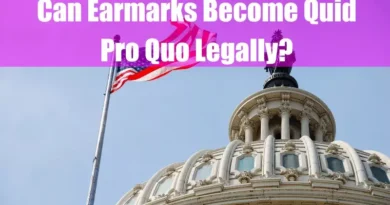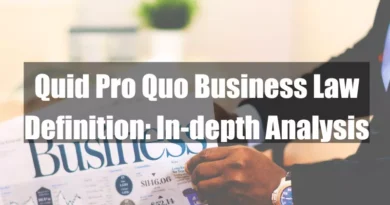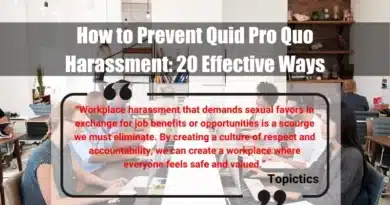Quid Pro Quo History: A Complex Dance of Mutual Exchange
The quid pro quo history is complex and varied. It has been used for good and bad purposes, and it is important to be aware of its potential for abuse. This article will explore the history of quid pro quo, its impact on society, and its potential for good and bad.
Quid pro quo is a Latin phrase. It means “something for something.” It describes a situation where two people exchange goods or services; each person only gets what they want if the other person also gets what they want. Quid pro quo can be used for both good and bad purposes.
For example, a business may offer a quid pro quo to a customer by offering a discount in exchange for a referral. A politician may offer a quid pro quo to a constituent by offering to support a project in their district in exchange for their vote. And a prosecutor may offer a quid pro quo to a defendant by offering a lighter sentence in exchange for a guilty plea.
Takeaways
| Key Points |
|---|
| Quid pro quo, meaning “something for something,” refers to exchanges where one party provides something of value in return for another. |
| This concept is illustrated through various historical and ethical examples. |
| For instance, a lemonade stand analogy simplifies the idea: exchanging work for lemonade demonstrates a basic quid pro quo. |
| However, such exchanges can range from ethical to exploitative, as seen in a 16th-century apothecary’s drug substitutions, which saved costs but risked patient safety, and Ferdinand and Isabella’s funding of Columbus’s voyage for territorial expansion. |
| In the 18th century, the British East India Company leveraged bribes and manipulations, exemplified by the Battle of Plassey, to consolidate power in India. |
| The 19th-century purchase of Alaska highlighted a strategic quid pro quo, where Russia relieved financial pressure by selling the territory to the U.S. for $7.2 million, benefiting both nations. |
| By the 20th century, unethical quid pro quo was evident in the Teapot Dome scandal, where U.S. officials accepted bribes for oil lease favors, eroding public trust. Modern examples include political controversies like Donald Trump’s alleged pressuring of Ukraine for personal political gain. |
An Analogy to Understand Quid Pro Quo
Imagine you are at a lemonade stand. You want to buy a glass of lemonade, but you don’t have any money. You ask the lemonade stand owner if you can work for a glass of lemonade. The lemonade stand owner agrees, and you spend the next hour working at the lemonade stand. In this example, you have exchanged your work for a glass of lemonade. This is a quid pro quo exchange.
Quid pro quo exchanges are common in all aspects of life. We exchange our time, skills, and resources for things we want or need. Quid pro quo exchanges can benefit both parties involved but can also be used to manipulate or exploit others.
Quid Pro Quo Exchange Unethical Example
A politician offers to give a government contract to a company in exchange for a campaign donation. This is a quid pro quo exchange because the politician is offering a favor to the company in exchange for something of value. This quid pro quo exchange is unethical because it gives an unfair advantage to the company that donated to the campaign.
Quid pro quo is a complex concept, and it can be difficult to determine whether a particular exchange is ethical or unethical. However, it is important to be aware of the potential for quid pro quo abuse and to be careful about entering into quid pro quo exchanges.
16th Century
1535: Quid Pro Quo in the Apothecary Shop
The first documented use of the phrase “quid pro quo” in English appears in a translation of a treatise by Erasmus. In this context, it refers to apothecaries substituting one drug for another.
Apothecaries were the pharmacists of the day, and they prepared and dispensed medicines to patients. However, they often needed access to the ingredients as modern pharmacists. They may have had to improvise when filling prescriptions. This could lead to quid pro quo substitutions, where the apothecary would substitute a different drug for the prescribed one.
There are a few reasons why apothecaries might use quid pro quo substitutions. One reason is that they may have been trying to save money. Another reason is that they may have believed the substitute drug was as effective as the prescribed one. However, quid pro quo substitutions could also be dangerous, as they could lead to patients receiving the wrong medication.
Ferdinand and Isabella Finance Columbus’s Voyage
In the 16th Century, Ferdinand of Spain and Isabella of Castile offered to finance Christopher Columbus’s voyage to the Americas in exchange for Columbus’s promise to return with riches and new lands. This is a classic example of a quid pro quo exchange, in which one party offers something of value to another party in exchange for something else.
Ferdinand and Isabella were motivated to finance Columbus’s voyage to expand their empire and acquire new resources. On the other hand, Columbus was motivated to explore the world and make a name for himself.
The quid pro quo exchange between Ferdinand Isabella and Columbus ultimately succeeded for both parties. Columbus returned from his voyage with news of new lands and some gold, but the scale of riches was much less than expected. Ferdinand and Isabella expanded their empire and acquired new resources. However, the exchange also negatively affected the indigenous peoples of the Americas, who were conquered and colonized by the Spanish.
18th Century
18th Century British East India Company
The British East India Company was a private company that was granted a monopoly on trade between England and India by the British Crown. The company’s officials were given great power and often used their power to enrich themselves.
In the 18th Century, the British East India Company engaged in various corrupt practices, including offering bribes to local rulers and officials as part of a broader strategy of manipulation, alliances, and military force to secure favorable treatment and expand their influence.
For example, in 1757, Robert Clive, a key figure in the British East India Company, engaged in bribery and manipulation to secure a decisive victory at the Battle of Plassey, promising substantial financial rewards and political power to Mir Jafar, the Nawab of Bengal, in exchange for his support—though the exact amounts and details were part of a larger, complex arrangement.
The company’s use of bribes helped it gain control over more territory in India. By the end of the 18th Century, the British East India Company was the dominant power in India.
19th Century
Purchase of Alaska
In the 19th Century, the term quid pro quo began to be used more broadly to refer to any exchange of goods or services, regardless of whether it was part of a formal contract. One example is the purchase of Alaska by the United States from Russia in 1867 for $7.2 million.
There were several reasons why Russia was interested in selling Alaska. First, it was a remote and sparsely populated territory that was difficult and expensive to defend. Second, Russia faced financial difficulties, and the sale of Alaska would provide much-needed cash. Third, Russia was concerned that the United States or Great Britain might eventually try to seize Alaska by force.
The United States was also interested in acquiring Alaska for several reasons. First, Alaska was seen as a potential source of valuable resources, such as gold, fish, and timber. Second, Alaska would give the United States a strategic foothold in the North Pacific Ocean. Third, Alaska would help to protect the western coast of the United States from attack.
The negotiations for the purchase of Alaska were conducted in secret between Russian Foreign Minister Eduard de Stoeckl and American Secretary of State William H. Seward. On March 30, 1867, the two sides signed a treaty agreeing to sell Alaska for $7.2 million. The United States Senate approved the treaty on April 9, 1867, and the Russian Tsar on May 11, 1867.
The purchase of Alaska was a controversial decision then, but it proved a wise investment in the long run. Alaska has become a major source of natural resources for the United States. It has played an important role in American national security.
The 1867 U.S. purchase of Alaska from Russia, orchestrated by Secretary of State William H. Seward, involved a payment of $7.2 million. This deal, driven by Russia’s desire to alleviate debt and America’s interest in expansion and resource acquisition, exemplifies a strategic quid pro quo.
20th Century
The Teapot Dome Scandal of the 1920s
The Teapot Dome scandal was a major political corruption scandal that occurred in the United States during the presidency of Warren G. Harding. The scandal involved Interior Secretary Albert Fall, who secretly leased two government oil reserves, Teapot Dome and Elk Hills, to private oil companies in exchange for bribes.
Fall was a close friend of Harding’s, and he had been appointed Interior Secretary in 1921. Fall strongly advocated for the private development of the government’s oil reserves, and he argued that it was in the country’s best interests to lease the reserves to private companies.
1922 Fall leased the Teapot Dome reserve to the Mammoth Oil Company. The lease was negotiated secretly, and Fall did not disclose his relationship with the company. Fall received a $100,000 bribe from Mammoth Oil in exchange for the lease.
In 1923, Fall leased the Elk Hills reserve to the Pan American Petroleum and Transport Company. Again, the lease was negotiated secretly, and Fall did not disclose his relationship with the company. In exchange for the lease, Fall received a $250,000 bribe from Pan American Petroleum and Transport.
The Teapot Dome scandal was first reported in the press in 1923. The Harding administration denied the allegations, but an investigation by the Senate found that Fall had indeed taken bribes in exchange for the leases. Fall was indicted on charges of conspiracy and bribery in 1924. He was convicted and sentenced to one year in prison.
The Teapot Dome scandal was a major scandal that damaged the Harding administration and led to a decline in public trust in the government. The Teapot Dome scandal also led to reforms in how the government manages its natural resources.
Recent Years
In recent years, the term quid pro quo has been used to describe several high-profile political scandals, including the Watergate scandal and the impeachment of President Donald Trump.
Here are some specific examples of historical quid pro quo incidents:
The Impeachment of President Donald Trump
In 2019, the House of Representatives impeached President Donald Trump for allegations of abusing his power and obstructing Congress. This impeachment resulted from Trump’s efforts to coerce Ukraine into probing his political adversary, Joe Biden.
On July 25, 2019, during a phone call with Ukrainian President Volodymyr Zelenskyy, Trump asked him to investigate Biden and his son, Hunter Biden, who had been employed on a Ukrainian energy company board.
Trump’s actions were seen as an attempt to use his position as president to gain an advantage in the 2020 election. He was impeached by the House of Representatives but was acquitted by the Senate.
FAQs
What does quid pro quo literally mean?
Quid pro quo is a Latin phrase meaning “something for something.” It describes a situation in which two parties exchange goods or services.
Why is quid pro quo illegal?
Because it can lead to corruption, abuse of power, and unfair treatment, it is unlawful when it involves the exchange of goods or services in an unethical or corrupt way.
What is an example of a quid pro quo case?
A government official offers to award a contract to a company in exchange for a bribe, or a supervisor demands sexual favors from an employee in exchange for a promotion.
What is the opposite of quid pro quo?
The opposite of quid pro quo is altruism. Quid pro quo is an exchange of goods or services, while altruism is selfless concern for others.
What is the synonym of quid pro quo?
A synonym of quid pro quo is “exchange.” Other synonyms are trade, barter, give-and-take, reciprocal agreement, pay-off, kickback, and bribe.








